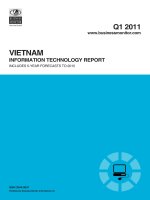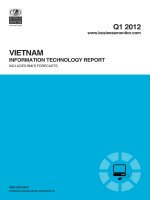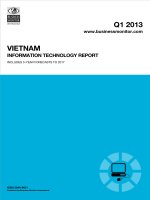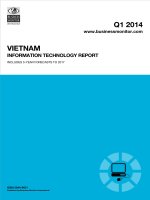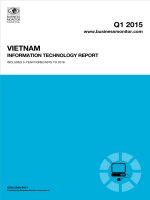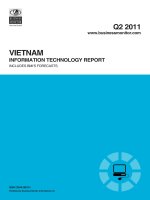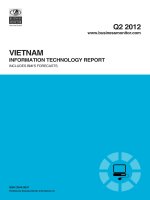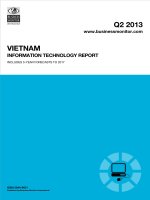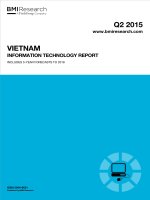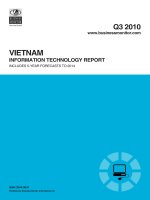Vietnam information technology report q4 2013
Bạn đang xem bản rút gọn của tài liệu. Xem và tải ngay bản đầy đủ của tài liệu tại đây (439.24 KB, 81 trang )
Q4 2013
www.businessmonitor.com
VIETNAM
INFORMATION TECHNOLOGY REPORT
INCLUDES 5-YEAR FORECASTS TO 2017
ISSN 2044-9631
Published by:Business Monitor International
Vietnam Information Technology
Report Q4 2013
INCLUDES 5-YEAR FORECASTS TO 2017
Part of BMI’s Industry Report & Forecasts Series
Published by: Business Monitor International
Copy deadline: October 2013
Business Monitor International
Senator House
85 Queen Victoria Street
London
EC4V 4AB
United Kingdom
Tel: +44 (0) 20 7248 0468
Fax: +44 (0) 20 7248 0467
Email:
Web:
© 2013 Business Monitor International
All rights reserved.
All information contained in this publication is
copyrighted in the name of Business Monitor
International, and as such no part of this
publication may be reproduced, repackaged,
redistributed, resold in whole or in any part, or used
in any form or by any means graphic, electronic or
mechanical, including photocopying, recording,
taping, or by information storage or retrieval, or by
any other means, without the express written consent
of the publisher.
DISCLAIMER
All information contained in this publication has been researched and compiled from sources believed to be accurate and reliable at the time of
publishing. However, in view of the natural scope for human and/or mechanical error, either at source or during production, Business Monitor
International accepts no liability whatsoever for any loss or damage resulting from errors, inaccuracies or omissions affecting any part of the
publication. All information is provided without warranty, and Business Monitor International makes no representation of warranty of any kind as
to the accuracy or completeness of any information hereto contained.
CONTENTS
BMI Industry View 7
SWOT 9
IT SWOT 9
Wireline SWOT 11
Political 13
Economic 14
Business Environment 15
Industry Forecast 16
Table: Vietnam IT Industry - Historical Data And Forecasts (VNDbn) 16
Broadband 21
Table: Telecoms Sector - Broadband - Historical Data And Forecasts 21
Macroeconomic Forecasts 23
Macroeconomic Forecast 23
Table: Vietnam - Economic Activity 26
Industry Risk Reward Ratings 27
Asia Risk/Reward Ratings 27
Table: Asia Pacific IT Risk/Reward Ratings, Q413 30
Market Overview 31
Hardware 31
Software 38
Services 49
Industry Trends And Developments 55
Regulatory Development 59
Table: Government Authority 59
Regulatory News 62
Company Profile 64
FPT Software 64
Table: FPT Group Revenue By Segment (VNDbn) 66
Table: Profit Before Tax Margin By Segment (%) 67
Regional Overview 68
Demographic Forecast 73
Table: Vietnam's Population By Age Group, 1990-2020 ('000) 74
Table: Vietnam's Population By Age Group, 1990-2020 (% of total) 75
Table: Vietnam's Key Population Ratios, 1990-2020 75
Vietnam Information Technology Report Q4 2013
© Business Monitor International Page 4
Table: Vietnam's Rural And Urban Population, 1990-2020 76
Methodology 77
IT Industry Forecasts 77
IT Risk/Reward Ratings - Methodology 78
Table: IT Business Environment Indicators 79
Weighting 80
Table: Weighting Of Components 80
Sources 80
Vietnam Information Technology Report Q4 2013
© Business Monitor International Page 5
BMI Industry View
BMI View: Vietnam's IT market is forecast grow strongly for the duration of our forecast period to 2017.
We forecast IT spending will increase by 17.6% in 2013 to reach a total value of VND62,082bn (US
$2.97bn), and grow at a CAGR of 14.1% to 2017. Significant opportunities remain in the market due to
relatively low penetration of devices and services, which vendors will be able to tap as incomes rise. The
government is also a significant factor underpinning our bright outlook as it pursues a range of ICT
initiatives and allocates funding to develop Vietnam's domestic IT industry. A key policy is the promotion of
Vietnam as an outsourcing destination, with the services segment expected to expand rapidly over the
medium term as enterprises, particularly in Japan, switch business away from China in search of cost
savings. ERP and security solutions will experience fast growth in the enterprise market, as well as
medium-term opportunities in cloud computing services as telecoms infrastructure improves.
Headline Expenditure Projections
■
Computer Hardware Sales: VND44,389bn in 2013 to VND68,935bn in 2017, CAGR of +12.5% in
local currency terms. PC sales growth picked up again from mid-2013 after a dip earlier in the year as
retailers cut prices and partnered with banks to provide credit.
■
Software Sales: VND5,610bn in 2013 to VND10,378nn in 2017, CAGR of +17.5% in local currency
terms. Piracy continues to be a drag on the market, but with large opportunities in business software and
security solutions we expect growth will remain robust in the medium term.
■
IT Services Sales: VND12,083bn in 2013 to VND22,812bn in 2017, CAGR of +18.2% in local currency
terms. Services expected to be the outperforming segment of the IT market as demand grows in several
verticals, including banking, telecoms, energy and government. Additionally, there is a potential boom in
outsourcing from Japanese enterprises to drive outperformance of services segment.
Risk/Reward Ratings
Vietnam scores 41.1 out of 100 in our Asia Risk/Reward Ratings table. This places the country 11th, ahead
of Sri Lanka and behind Philippines and Thailand.
Key Trends & Developments
The PC market in Vietnam remains a target for vendors due to the low level of PC penetration, which in
2011 was less than half the level of China and around a quarter of the level in Malaysia. As incomes rise
vendors are able to tap the first time buyer market and achieve rapid unit growth. However, the
development of the market slowed slightly in H113 as a lack of credit restricted sales of what remain big-
ticket purchases for the majority of Vietnamese. The situation improved from mid-2013 as retailers such as
Vietnam Information Technology Report Q4 2013
© Business Monitor International Page 7
Vien Thong A, Dienmay.com, Phong Vu, Hoan Long and Nguyen Kim cut prices and partnered with
banks including HSBC, VietinBank, ANZ and Sacombank to directly offer interest free instalment
payment plans. Despite this boost for vendors, sales of notebooks continue to be squeezed by competition to
international vendors from low-price Chinese tablets such as Hipad, Ondan, Teclast and Ampe. These
products are undercutting traditional notebooks on price, even after local dealers benefit from high mark-
ups. The margins available mean they are being heavily promoted by local retailers.
The government has moved to address some of the issues slowing the development of the IT market,
particularly the outsourcing market which has the potential to be one of the fastest growing segments of the
IT market. Cyber security issues are prominent among client concerns dealing with outsourcing operations
in Vietnam, and in August 2013 the government announced it was investing US$42mn in the creation of the
National Centre for Network Security Technology, which followed an update of the Law on Information
Security, which closed for public comment in July 2013, as the government looks to strengthen cyber
security and improve the legal environment. BMI considers these positive steps which will help Vietnam to
tap demand from Japanese, and other enterprises, that are considering switching from China or India to
Vietnam to capitalise on cost advantages.
Vietnam Information Technology Report Q4 2013
© Business Monitor International Page 8
SWOT
IT SWOT
SWOT Analysis
Strengths
■
Government policies and funding in place to promote the development of the IT
sector.
■
Vietnam's gradual integration into the global trade network via its accession into trade
organisations such as ASEAN and WTO, as well as bilateral agreements with Japan
and China.
■
The domestic IT market is in a rapid growth phase, with trade liberalisation and
growing affordability driving Increased adoption among enterprises and consumers.
Weaknesses
■
IT spend per capita much lower than in neighbouring Thailand, reflecting a much
lower GDP and GDP per capita.
■
Limited access to credit and budgets restrain spending by SMEs.
■
Highly cost-sensitive market, with 75% of software provided by lower-cost local
software vendors.
■
High level of software piracy, although some progress has been made in recent years.
Opportunities
■
Low PC penetration means there is scope for vendors to tap first time buyer market
as well as the upgrade/replacement market.
■
Low-cost tablets are proving popular with consumers, with significant medium term
sales growth potential.
■
Vietnam is becoming a popular destination for outsourcing, with particularly strong
growth potential from Japanese enterprises.
■
National IT Plan will drive spending on IT utilisation in areas such as e-government, e-
taxation and education.
Vietnam Information Technology Report Q4 2013
© Business Monitor International Page 9
SWOT Analysis - Continued
■
SMEs have much potential to increase spending on basic solutions, including
customer relationship management and security.
■
The government's drive to create a significant IT services industry over the next 15-20
years is expected to be a significant factor shaping the IT market through incentives
to create IT clusters.
Threats
■
The implementation of the China-ASEAN free trade agreement means that
established multinationals will face a growing challenge from low-cost Chinese
vendors in the Vietnamese market.
■
Low cost tablets from own-brand Chinese vendors a particular threat to low- and
mid-range notebook vendors. Falling prices may further undermine margins and
profitability after steep discounting.
■
Cyber security issues could undermine confidence in IT solutions and services, with
Big Data and cloud computing vulnerable.
Vietnam Information Technology Report Q4 2013
© Business Monitor International Page 10
Wireline SWOT
Wireline SWOT
Strengths
■
Fixed-line penetration levels and internet user rates are high in major urban centres
such as Ho Chi Minh City, Hanoi, Danang and Haiphong.
■
Competition exists in fixed-line and internet access markets; VNPT faces competition
from several other state-owned companies and privately owned operators.
■
High levels of literacy and other demographic factors bode well for strong and
continued demand for wireline services over the next few years.
Weaknesses
■
Vietnam's fixed-line and internet access markets are dominated by state-controlled
operator VNPT.
■
Although alternative broadband infrastructures are currently being explored,
broadband growth continues to be highly dependent on DSL.
■
Low fixed-line penetration rates in rural regions limit the scope for DSL broadband
growth.
■
Although internet user growth is improving, rural Vietnam still has limited access to
internet infrastructure.
■
Broadband tariffs remain high, creating a barrier for low-income subscribers to
access.
Opportunities
■
The privatisation of VNPT could help to bring about increased investment revenue
and the arrival of new skills.
■
On a national level, broadband penetration rates remain low - this means that the
sector has considerable growth potential.
■
Significant opportunities exist to develop alternative broadband technologies,
including WiMAX, LTE and fibre; WiMAX and LTE internet services have the potential
to raise the level of internet user penetration in rural parts of Vietnam.
Vietnam Information Technology Report Q4 2013
© Business Monitor International Page 11
Wireline SWOT - Continued
■
Draft Bill of Law on Telecommunication has been put forward for discussion at the
National Assembly Steering Committee. If passed, the bill will allow private
companies to build network infrastructure for the first time and will open up the
telecoms market to foreign investors.
Threats
■
Fixed-line sector may enter a period of decline, with potentially negative
consequences for DSL growth.
■
As the market for mobile data services grows, this could have potentially negative
consequences for the growth of fixed broadband services.
■
VTV's dominance in the pay-TV sector is holding back market development.
Vietnam Information Technology Report Q4 2013
© Business Monitor International Page 12
Political
SWOT Analysis
Strengths
■
The Communist Party of Vietnam remains committed to market-oriented reforms and
we do not expect major shifts in policy direction over the next five years. The one-
party system is generally conducive to short-term political stability.
■
Relations with the US have witnessed a marked improvement, and Washington sees
Hanoi as a potential geopolitical ally in South East Asia.
Weaknesses
■
Corruption among government officials poses a major threat to the legitimacy of the
ruling Communist Party.
■
There is increasing (albeit still limited) public dissatisfaction with the leadership's tight
control over political dissent.
Opportunities
■
The government recognises the threat corruption poses to its legitimacy, and has
acted to clamp down on graft among party officials.
■
Vietnam has allowed legislators to become more vocal in criticising government
policies. This is opening up opportunities for more checks and balances within the
one-party system.
Threats
■
Macroeconomic instabilities in 2012 are likely to weigh on public acceptance of the
one-party system, and street demonstrations to protest economic conditions could
develop into a full-on challenge of undemocractic rule.
■
Although strong domestic control will ensure little change to Vietnam's political scene
in the next few years, over the longer term, the one-party-state will probably be
unsustainable.
■
Relations with China have deteriorated over recent years due to Beijing's more
assertive stance over disputed islands in the South China Sea and domestic criticism
of a large Chinese investment into a bauxite mining project in the central highlands,
which could potentially cause wide-scale environmental damage.
Vietnam Information Technology Report Q4 2013
© Business Monitor International Page 13
Economic
SWOT Analysis
Strengths
■
Vietnam has been one of the fastest-growing economies in Asia in recent years, with
GDP growth averaging 7.1% annually between 2000 and 2012.
■
The economic boom has lifted many Vietnamese out of poverty, with the official
poverty rate in the country falling from 58% in 1993 to 14.0% in 2010.
Weaknesses
■
Vietnam still suffers from substantial trade, current account and fiscal deficits, leaving
the economy vulnerable to global economic uncertainties in 2012. The fiscal deficit is
dominated by substantial spending on social subsidies that could be difficult to
withdraw.
■
The heavily-managed and weak currency reduces incentives to improve quality of
exports, and also keeps import costs high, contributing to inflationary pressures.
Opportunities
■
WTO membership has given Vietnam access to both foreign markets and capital,
while making Vietnamese enterprises stronger through increased competition.
■
The government will in spite of the current macroeconomic woes, continue to move
forward with market reforms, including privatisation of state-owned enterprises, and
liberalising the banking sector.
■
Urbanisation will continue to be a long-term growth driver. The UN forecasts the
urban population rising from 29% of the population to more than 50% by the early
2040s.
Threats
■
Inflation and deficit concerns have caused some investors to re-assess their hitherto
upbeat view of Vietnam. If the government focuses too much on stimulating growth
and fails to root out inflationary pressure, it risks prolonging macroeconomic
instability, which could lead to a potential crisis.
■
Prolonged macroeconomic instability could prompt the authorities to put reforms on
hold as they struggle to stabilise the economy.
Vietnam Information Technology Report Q4 2013
© Business Monitor International Page 14
Business Environment
SWOT Analysis
Strengths
■
Vietnam has a large, skilled and low-cost workforce, which has made the country
attractive to foreign investors.
■
Vietnam's location - its proximity to China and South East Asia, and its good sea links
- makes it a good base for foreign companies to export to the rest of Asia, and
beyond.
Weaknesses
■
Vietnam's infrastructure is still weak. Roads, railways and ports are inadequate to
cope with the country's economic growth and links with the outside world.
■
Vietnam remains one of the world's most corrupt countries. According to
Transparency International's 2012 Corruption Perceptions Index, Vietnam ranks 123
out of 176 countries.
Opportunities
■
Vietnam is increasingly attracting investment from key Asian economies, such as
Japan, South Korea and Taiwan. This offers the possibility of the transfer of high-tech
skills and know-how.
■
Vietnam is pressing ahead with the privatisation of state-owned enterprises and the
liberalisation of the banking sector. This should offer foreign investors new entry
points.
Threats
■
Ongoing trade disputes with the US, and the general threat of American
protectionism, which will remain a concern.
■
Labour unrest remains a lingering threat. A failure by the authorities to boost skills
levels could leave Vietnam a second-rate economy for an indefinite period.
Vietnam Information Technology Report Q4 2013
© Business Monitor International Page 15
Industry Forecast
Table: Vietnam IT Industry - Historical Data And Forecasts (VNDbn)
2010 2011 2012 2013f 2014f 2015f 2016f 2017f
IT Market Value 36,898 45,404 52,773 62,082 70,836 80,399 90,746 102,126
o/w Hardware 27,305 33,372 38,261 44,389 49,939 55,877 62,161 68,935
- PC 22,117 27,098 31,374 36,754 41,350 46,378 51,594 57,216
- Servers 2,457 3,003 3,443 3,995 4,495 5,029 5,594 6,204
o/w Software 3,051 3,868 4,630 5,610 6,593 7,708 8,961 10,378
o/w Services 6,542 8,165 9,882 12,083 14,303 16,814 19,624 22,812
IT Market, % of
GDP 1.86 1.79 1.79 1.87 1.90 1.92 1.93 1.93
f = BMI forecast. Source: BMI.
BMI forecasts Vietnam will be one of the fastest growing IT markets in APAC over the medium term,
albeit from a low base, but the IT sector will account for a growing share of GDP over the duration of our
five-year forecast to 2017. We expect the IT market in Vietnam will expand to VND62,082bn in 2013, an
increase of 17.6% from VND52,773bn in 2012. We expect strong growth to continue over the medium,
term with a compound annual growth rate (CAGR) of 14.1% 2013 to 2017, with the value of the market
reaching VND102,126bn in 2017. There will be double digit CAGR for all three segments of the market.
However, we expect software and services growth to outperform hardware and account for an increasing
share of the total market over the five years to 2017.
The major trends driving this strong growth include increases in PC penetration - driven by the supply of
cheaper hardware from Chinese vendors and a new generation of devices running Windows 8. Supporting
this trend will be moves by retailers to partner with banks in credit provision for PC purchases,
improvements in network infrastructure and rising real incomes. Government spending and policy will also
add to growth, through procurement initiatives, investments in hi-tech industrial parks and policies designed
to boost the sector such as improvements to IT education and security certification schemes for firms.
Meanwhile, despite global economic headwinds presenting a risk, Vietnam's software development and
outsourcing services firms are positioned to benefit from large foreign enterprises seeking lower cost
locations over the medium term.
Vietnam Information Technology Report Q4 2013
© Business Monitor International Page 16
2013 Outlook
Despite a small downward revision by BMI to its
macroeconomic outlook for Vietnam in 2013
conditions remain supportive of IT market
expansion. We forecast real GDP growth will pick
up to 5.3% in 2013 from 5.2% in 2012, however it
should be noted that the forecast for 2013 has been
revised down from 7% since the Q2 2013 update.
There was a small drag on retail spending in H113
due to limited access to credit, however partnerships
between banks and retailers have returned the market
to faster growth from mid-2013. Ggovernment
spending is expected to increase by 6.2% in real
terms, again up from 2012, and further, we expect IT
spending growth to outpace overall government
spending due to the policy goal of developing the
sector. This is evidenced by the Ministry of
Information and Communication's August 2013
proposal to allocate at least 2% of the state budget to boosting the IT sector each year.
BMI expects strong sales in the retail PC market to continue through 2013, following a small dip in H113,
as retailers have moved to partner with banks and ensure credit is available for big ticket purchases. The
market will gain additional momentum from the impact of new vendors entering the market and existing
vendors releasing new models, including Android tablets and Microsoft Windows 8 based tablets, hybrids/
convertibles and ultrabooks. Most recently the influx of low-priced Chinese own-brand tablets that has
deepened the market and vendors in the notebook category have been lowering prices to compete with this
influx, which has helped make devices more affordable and boosted sales.
Government spending and PC subsidy programmes will be supportive of the PC market in 2013 as the
government continues to roll-out IT modernisation programmes. The government has been spending heavily
on IT, with around 50% of this going to hardware in recent years. It has also spent heavily on licensing
software used by government agencies, but in 2013 the Ho Chi Minh City government is beginning a push
to increase the utilisation of open-source software, which could be replicated elsewhere.
Industry Trends - IT Market
2010-2017
f = BMI forecast. Source: BMI.
Vietnam Information Technology Report Q4 2013
© Business Monitor International Page 17
Another area of the market performing strongly in 2013 is the outsourcing services market. Several pieces
of research have shown that Vietnam is now the first choice for Japanese enterprises looking to outsource
functions, primarily based on the cost advantages offered. The majority of Japan's corporate outsourcing is
still directed to China in terms of value, but software and business process outsourcing has significant cost
advantages in Vietnam, as well as a friendly business environment. This could see rapid growth as firms
shift from China to Vietnam, and the potential for international demand from elsewhere could sustain the
boom.
Drivers
Government policies and funding are an important part of the sector's development in Vietnam. Policies
include promoting the use of IT by government agencies, citizens and enterprises - as well as promoting the
development of local industry, particularly in software and outsourcing services.
Examples of policies include plans to modernise IT in government agencies and the customs department, as
well as the Tax Administration Modernisation Plan for 2008-2013. A number of government ministries and
organisations, including the Ministry of Education and Training, have also started to promote the roll-out of
cloud services. The government has also promoted the IT industry through policy and incentives to grow hi-
tech parks, both for the construction of IT hardware, but increasingly software and IT services.
A specific IT development initiative is the government's drive to grow the IT services industry over the next
15-20 years. The cost of outsourcing in Vietnam was estimated in 2013 research to be as much as 30%
lower than in China, a fact which Japanese firms were especially aware of. The momentum that could be
garnered from Japanese enterprises shifting business process and software development outsourcing to
Vietnam could see medium term increases from European and North American demand.
However growth will depend on government progress on various business environment issues, including
copyright protection and combating cyber security threats. Further progress in combating software piracy,
which is still reported to be at higher levels than in China, India and Thailand, despite some progress in
recent years, is required. It is also taking steps to increase the penetration of information security
certification by distributing funds to enterprises. In August 2013 it was reported that the government was
investing US$42mn in the creation of the National Centre for Network Security Technology. The
government is also updating the Law on Information Security, which closed for public comment in July
2013, as it looks to improve the cyber security environment including combating attacks originating in
Vietnam.
Vietnam Information Technology Report Q4 2013
© Business Monitor International Page 18
Improvements to supporting infrastructure are also driving IT market development. Telecoms operators are
investing in the expansion of both wireline and wireless broadband network infrastructure to rural areas, as
well as upgrading capacity of urban infrastructure and improving backbone networks. Additionally,
telecoms operators such as Viettel are emerging as significant distribution channels for notebooks as
vendors seek tie-ups. In a country where PC penetration remains low, particularly in rural areas,
government digital divide programmes to boost internet and digital utility in rural areas underpin
addressable market growth and open PC ownership to a growing number of rural inhabitants.
Tariff reductions, particularly the ASEAN ones, have contributed to lower prices and are boosting PC sales.
However, the new China-ASEAN free trade agreement offers both opportunities and challenges to vendors,
given the growing presence of low-cost Chinese vendors in the Vietnamese market. Reports from Q113
indicate that international vendors have suffered in particular against the supply of cheap own-brand
Chinese tablets. Local dealers are promoting the devices because of the margins available, but even with
this mark-up they are proving a big-hit and hurting sales of traditional notebooks.
Segments
In Vietnam the government is a key IT spending vertical and accounts for around 30% of total Vietnamese
IT spending, with high levels of investment in hardware. Spending has continued to grow both at central
and regional government level. Most recently in April 2013 the Ho-Chi Minh City authority announced
plans to spend VND300bn (US$14.3mn) on developing e-government capacity. It will also focus on
replacing out of date hardware and improving network security in 2013. An additional feature is the
authority's intention to work with local small and medium IT enterprises where possible, rather than
immediately turning to large IT vendors. Spending in 2013 is a marked increase over the 2005-2012 period
when the city authority carried out 1,012 projects with a total spend of VND665bn.
Large Vietnamese companies are the most likely to buy packaged software from multinationals, which have
only around 25% of the local software market. In the large corporate sector, growing demand for digital
infrastructure projects in segments such as banking, telecoms and energy has attracted global IT services
leaders, such as IBM, to invest in Vietnam. Foreign investment, particularly by Japanese companies, in call
centres and other areas will help to grow the market. The banking and finance sector is a promising area for
database software and one where foreign companies have done well. Spending opportunities in the finance
segment will be driven by regulatory compliance, due to regulations such as Basel II, HIPPA and the
Sarbanes-Oxley Act, and quite likely by new regulations introduced in the wake of the global financial
crisis.
Vietnam Information Technology Report Q4 2013
© Business Monitor International Page 19
Smaller enterprises have a lower penetration of enterprise software, including ERP and security software,
but due to price sensitivity favour local solutions. The SME market is an area of the market in which
vendors can achieve growth as SME awareness of the benefits of IT utilisation increase, encouraged by
government initiatives to modernise firms and improve international competitiveness. However, vendors
will have to face the challenge of enterprises that are constrained by low budgets and lack of access to
credit. Companies are looking for software that will help boost performance and operational efficiency.
Promising SME verticals include discrete manufacturing and consumer packaged goods, as well as hotels
and property management. The solution areas with most demand currently include security software and
key applications such as CRM, ERP and HR management.
An increasing number of Vietnamese companies have shown an interest in and willingness to use cloud
services, although the market is only in the early stages of development. In the short term weaknesses in
telecoms infrastructure - in terms of reach and capacity - will limit cloud service adoption, but this barrier
will erode over the medium term. The government has also got involved in encouraging the development of
this business model in Vietnam and new cloud computing offerings and increased competition in this
segment should fuel further demand from end-users to utilise this technology.
Summary
Overall, the hardware market is anticipated to grow from VND44,389bn in 2013 to VND68,935bn in 2017,
with computer sales rising from VND36,754bn to VND57,216bn over the same period. Software spending
should rise from VND5,610bn to VND10,378bn and IT services from VND12,083bn to VND22,812bn over
the forecast period.
Vietnam Information Technology Report Q4 2013
© Business Monitor International Page 20
Broadband
Table: Telecoms Sector - Broadband - Historical Data And Forecasts
2010 2011 2012e 2013f 2014f 2015f 2016f 2017f
No. of internet users ('000) 26,905 31,159 31,470 32,100 32,742 33,397 34,064 34,746
No. of internet users/100 inhabitants 30.6 35.1 35.1 35.4 35.8 36.1 36.5 36.9
No. of fixed broadband internet subscribers ('000) 3,644 4,085 4,775 4,966 5,115 5,218 5,322 5,428
No. of fixed broadband internet subscribers/100
inhabitants 4.1 4.6 5.3 5.5 5.6 5.6 5.7 5.8
e/f = BMI estimate/forecast. Source: BMI, VNNIC
According to data provided by the Vietnam Internet
Network Information Centre (VNNIC), there were
31.3mn internet users in Vietnam at the end of
November 2012, up from 30.6mn in 2011. Vietnam's
internet sector continued to exhibit slower growth in
2012, continuing on from the trend seen in 2011.
The average monthly growth rate for 2011 was
1.1%, which was lower than the growth average in
2010 (1.4%). The first 11 months of 2012 saw even
weaker growth with an average m-o-m growth rate
of just 0.2%. Given that the number of 3G
subscriptions has surged in the past year, it is
possible that the VNNIC does not take into account
mobile internet users in its definition.
Fixed internet services are experiencing muted
growth due to the higher cost of ownership as
consumers need to purchase personal computers,
namely desktops and notebooks. There has been no explanation for the sudden decline in subscriber growth,
but market saturation is likely to play a significant role. We now expect 32.1mn internet subscribers in
Vietnam at the end of 2013, a penetration rate of 35.4%. We expect this number to increase to 34.7mn by
end-2017, a 36.9% penetration rate.
Industry Trends - Broadband
Sector
2010-2017
e/f = BMI estimate/forecast. Source: BMI, VNNIC
Vietnam Information Technology Report Q4 2013
© Business Monitor International Page 21
Although the internet user penetration rate is expected to be approaching saturation in major cities and
towns, rural Vietnam remains comparatively untapped as a result of consumers' lower purchasing power.
However, expansion into these areas is costly and the return on investment is not as attractive. Mobile
internet services are a more efficient way to capture customers in rural areas.
Vietnam's fixed broadband subscriber market grew by 22.8% in 2010, which was a significant slowdown
from 44.8% in the preceding year. The market registered growth rates of 150.3% in 2007 and 58.3% in
2008, but the higher growth momentum could be attributed to a low-base effect.
Like the overall internet sector, Vietnam's broadband industry is experiencing a slowdown. There were
4.3mn broadband subscribers at the end of November 2012, up by 8.0% y-o-y. The average monthly growth
rate in the first 11 months of 2012 was 0.5%, down from the 1.0% in the whole of 2011. This was due to the
contractions in the months ended June 2012, September and November 2012. We have raised our
broadband forecasts this quarter, however, in light of strong growth reported in the ministry's subscriber
figures. According to MIC, there was a surge in broadband subscribers in end-2012, and, by end-March
2013, there were 4.8mn subscribers in the country.
Although Vietnamese telecoms companies continue to deploy broadband services such as fibre-to-the-x,
affordability and coverage remain key concerns in the emerging market. Furthermore, demand for
traditional fixed broadband services is increasingly under threat from mobile alternatives due to a lower cost
structure. While we believe there will be limited growth potential for the fixed broadband industry in
Vietnam in the near future, we retain an optimistic view in light of Vietnam's growing affluence and
expanding middle class. While next-generation mobile technologies LTE and WiMAX could cannibalise
demand for fixed broadband solutions, companies could generate consumer interest by introducing
bandwidth-intensive services such as IPTV or target businesses by offering bundled packages such as cloud
solutions.
We expect the growth rate of the Vietnamese broadband market to decline in the next few years as
consumers opt for mobile alternatives. That said, declining prices of products and services should help the
sector to grow by an average of 2.0% between 2013 to 2017 to bring the total number of fixed broadband
subscribers in Vietnam to 5.4mn.
Vietnam Information Technology Report Q4 2013
© Business Monitor International Page 22
Macroeconomic Forecasts
Macroeconomic Forecast
Vietnam's economic recovery is beginning to lose its momentum, with the country recording a relatively
weak real GDP growth figure of 5.0% year-on-year (y-o-y) in Q213, up only slightly from 4.9% in Q113.
The latest GDP print also suggests to us that further efforts by the Vietnamese government to speed up the
restructuring of debt-laden banks and restart lending to small and medium-sized enterprises (SMEs) may be
necessary to support economic growth over the coming quarters. Moreover, given that we have recently
begun to see signs of a slowdown in economic activity across the region, 2013 looks increasingly precarious
for the Vietnamese economy.
Not A Good Year
Vietnam - Real GDP, VNDbn (LHS) & % chg y-o-y (RHS)
Source: BMI, General Statistics Office
Hint Of A Weak PMI Release
The latest GDP print also suggests that the HSBC Vietnam manufacturing purchasing mangers' index (PMI)
for June, which is scheduled for release later this week, is likely to come in relatively weak. As the
Vietnam Information Technology Report Q4 2013
© Business Monitor International Page 23
accompanying chart shows, Vietnam's PMI initially exhibited signs of a sustained expansion in
manufacturing sector growth in March, before recent data indicated that the sector has fallen back into
contraction territory (PMI came in at 48.8 in May, compared to 50.8 and 51.0 in March and April,
respectively). On the whole, we maintain a cautious outlook on the manufacturing sector in H213, as the
sector remains heavily dependent on external demand to drive growth.
As we have highlighted in recent articles, the long-awaited establishment of the Vietnam Asset
Management Company (VAMC) to clean up the build-up of bad debt across the banking sector should help
to ease credit conditions for businesses over the coming months (see 'All Eyes On New Debt Management
Company', June 28 2013). However, we argue that the pace of the recovery will be highly dependent on the
smooth and timely implementation of banking sector reforms by the government. Indeed, further delays in
implementing banking reforms and the lack of clarity over how the government will address the country's
deteriorating fiscal position as a result of rescuing the banking sector over the longer term, could risk
undermining investors' confidence in the economy.
Stalled Lending A Major Drag On Economy
Vietnam - Purchasing Managers' Index
Source: BMI, Markit/HSBC
Vietnam Information Technology Report Q4 2013
© Business Monitor International Page 24
Surge In FDI Inflows A Sign Of Confidence
On a more positive note, we continue to see evidence that foreign direct investment (FDI) inflows into the
country have remained resilient despite the lack of progress on banking reforms and the weak economic
data. According to figures published by the Ministry of Planning and Investment (MPI), FDI inflows into
Vietnam grew by 16.0% y-o-y to US$10.5bn in H113. FDI in new projects were worth US$5.8bn, an
increase of 3.7% over the same period. This is in line with our view that Vietnam's long-term prospect
remain bright and that the influx of FDI inflows will provide a significant boost to real gross fixed capital
formation (GFCF) growth over the coming quarters. We forecast GFCF growth to come in at 4.4% this
year, before accelerating towards 4.8% in 2014. Accordingly, we expect real GDP growth to come in at
5.3% in 2013 before accelerating towards 6.0% in 2014.
Expenditure Breakdown
Private Consumption: We expect private consumption to grow at a relatively resilient pace of 4.6% in
2013. However, we note that the risk of further bankruptcies among SMEs could potentially lead to
widespread job losses, especially in export-driven sectors. Uncertainties over the outlook for employment
could, in turn, prompt households to cut back on spending.
Gross Fixed Capital Formation: We foresee a pickup in private sector investment growth in 2013, partly
led by increased foreign direct investment inflows. We believe lending rates will gradually ease over the
coming months as the effect of recent rate cuts by the SBV begins to kick in. We are also seeing evidence
that credit conditions are improving. Accordingly, we expect gross fixed capital formation growth to
accelerate slightly from 4.3% in 2012 to 4.4% in 2013.
Public Spending: We expect total public spending to remain relatively resilient in 2013, expanding at a
respectable pace of 6.5%. However, there is limited room for the government to increase spending further
owing to concerns over the need to finance a potential bailout of ailing state-owned commercial banks.
Net Exports: Net exports remain the biggest downside risk to our outlook for the Vietnamese economy,
although we expect external demand to pick up through H213. Vietnam's trade account has fallen back into
deficits in recent months, but we see the case for a substantial pickup in external demand on the back of a
rebound in regional growth over the coming quarters. Accordingly, we still expect exports to expand at a
moderate pace of 5.5% in 2013.
Vietnam Information Technology Report Q4 2013
© Business Monitor International Page 25
